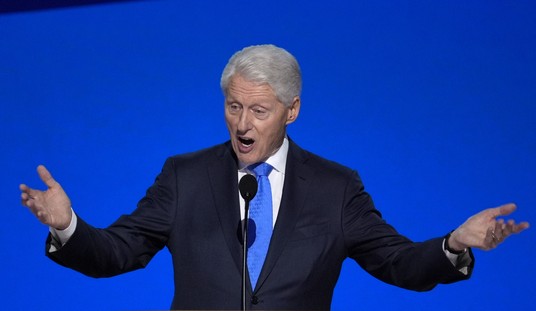Maybe this was inevitable after Senate Democrats started passing budgets again after a four-year hiatus. That was the last time we heard about using infrastructure spending as a stimulus, when it flopped in Barack Obama’s ARRA program, otherwise known as Porkulus. One of Obama’s advisers at that time, former OMB director Peter Orszag, warns that the nation’s infrastructure is ready to crumble unless we start spending big money to rescue it — and now, apparently, is the “perfect time” to start borrowing heavily to do it:
Roads, bridges and other infrastructure in the U.S. are steadily growing older and weaker. Given low interest rates and elevated unemployment, this is an ideal moment to invest in fixing them.
Our structures are aging as fast as we are. From 2000 to 2010, the median human age in the U.S. rose by almost two years, from 35.3 to 37.2, and the average age of nonresidential corporate fixed assets increased by about the same amount. Fixed assets as a whole aged from an average of 20.7 years to 22.1.
Does age matter? Unfortunately, with infrastructure it does.
A December 2010 report from the Department of Homeland Security underscores the threat. “Age,” it says, “often acts together with and may reinforce the effect of other factors such as design, maintenance, and operation in increasing the vulnerability of infrastructure.”
How do we find the money for this — which Orszag says will require $250 billion up front? Easy — issue bonds:
First, we need to couple immediate federal spending on public assets with substantial, credible deficit-reduction measures that are scheduled to take effect later on. Such a “barbell”approach to fiscal policy would require that Republicans acknowledge the value of additional stimulus while the unemployment rate is high, and that Democrats see how Medicare, Medicaid and Social Security could be preserved and strengthened through certain cost-saving measures over time. The upfront piece should include an ambitious $250 billion infrastructure program (including federal, state and local spending) over the next two years.
Second, we should bring back Build America Bonds. The traditional approach to state and local infrastructure financing allows the interest on the bonds to be excluded from federal taxation. That approach has been shown to provide undue benefit to purchasers in the top marginal-tax bracket. Build America Bonds, in contrast, provide a direct subsidy to the borrowers, and thereby deliver more of the federal subsidy to the state and local governments.
More than 2,000 Build America Bonds were issued in 2009 and 2010, and the Treasury Department has estimated that state and local governments have saved $20 billion in present value as a result. It’s time to bring the program back.
Good thing we paid off all the borrowing from Orzsag’s last round of stimulus and infrastructure spending, huh? Oh, wait …
Here’s a good question to ask: just how bad is our infrastructure? The Obama administration certainly likes to tell scary stories about it, but after the Nightmare on Sequester Street, a little double-checking might be in order. Rick Newman at US News revealed yesterday that American infrastructure isn’t anywhere near as bad as politicians like to claim when demanding more spending:
We’ve gotten so used to the narrative of America as a has-been nation that we tend to readily accept all evidence of decline. But if America has a critical infrastructure problem, business leaders aren’t aware of it. In its latest global competitiveness index, the World Economic Forum ranked the United States 14th out of 144 nations for the quality of its infrastructure. The top 10 were dominated by small places such as Singapore and Hong Kong, along with European nations with proficient rail systems and strong labor unions able to lobby effectively for construction projects. The United States, by contrast, is a huge landmass with inherent infrastructure challenges. So 14th is a pretty good showing.
Yet many news outlets duly reported the ASCE grade as if broken-down America is a fact beyond dispute. This woe-is-America storyline matters for a couple of reasons. First, the ASCE’s grade is regarded as authoritative. It’s routinely cited by politicians to lobby for more infrastructure spending, or to prove that America is going down the tubes under the current leadership (which, naturally, ought to be replaced). Second, it contributes to a declinist mentality which itself may be one of America’s biggest problems.
In real life, things often work better than the ASCE grade suggests. Take aviation, one of 16 categories ASCE analyzes, which earned a D in the latest report. The reason: Delays caused by congestion supposedly cost the economy $22 billion in 2012, with government projections claiming they’ll cost $34 billion by 2020 and $63 billion by 2040.
Yet in some ways, the aviation system is more efficient than ever. In 2012, nearly 84 percent of airline flights arrived on time, the highest percentage in the 17 years the government has been tracking such data. The rate of mishandled baggage hit an all-time low. Airfares, meanwhile, were 15 percent lower than they were in 1995, accounting for inflation. And aviation safety consistently improves, with airplane crashes now extremely rare.
What is ACSE, you may ask? ACSE is the American Society of Civil Engineers, the same industry that would benefit from a lot more government spending on infrastructure. Their rating system, Newman points out, doesn’t suffer from grade inflation as a result:
So it’s curious that the engineers who build those roads and bridges rate America’s infrastructure as far worse than most of the public would if you asked them. In its latest report on the state of the nation’s infrastructure, the American Society of Civil Engineers gave the United States the shocking grade of D+. If there’s any good news, it’s that the latest grade improves on the D handed out the last time ASCE published such findings, in 2009.
“Curious”? I’d call it “rent-seeking,” but then again, I’m just a big old cynic when it comes to demands for increased public spending. The rent in this case is $157 billion a year, by the way:
The ASCE wants government at all levels to spend $157 billion more per year to repair and maintain all those systems. It’s unlikely to happen: That would be nearly twice the $85 billion in federal spending cuts that just went into effect under the sequester.
John Boehner has a proposal for Democrats who want to talk infrastructure spending. He’s willing to increase the allocations for that purpose, but only if the money comes from a specific new source of revenue:
As Congress continues to hunt for ever-elusive money to rebuild roads, bridges and transit systems, House Republicans are likely once again to turn to black gold.
In the tax-averse and conservative-heavy conference, transportation interest groups’ ideas about raising the gasoline tax or looking at distance-based fees are a tough sell. But expanding oil and gas drilling and using those revenues for infrastructure improvements represent what Speaker John Boehner has called a “natural link.”
That’s one way to test whether Democrats are serious about infrastructure repair, or are looking only to create more pork-barrel projects for people back home — as the ARRA “Porkulus” did in 2009 and 2010.







Join the conversation as a VIP Member